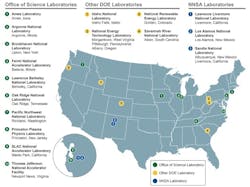Microgrid testing has become a large focus at smart grid research labs, according to survey results recently released by the Smart Grid Interoperability Panel (SGIP).
SGIP, a non-profit consortium of energy-related stakeholders, found that more than half of the labs surveyed now have microgrid test beds.
In its second year, the 2016 North American Test Bed Survey collected the data from researchers at national labs, as well as those working in academic settings, and for utilities and industry. The goal of the survey is to encourage collaboration among the various labs.
Microgrid resources tested
Solar PV is the largest generation source (41 percent) used in microgrid testing. Battery storage is also a big focus, with 39 percent of those surveyed examining it as part of a microgrid.
And electric vehicles — which soon are expected to be included in microgrids — are also catching the attention of researchers, with 20 percent of test beds studying them.
Only 5 percent of the labs are using combined heat and power in their microgrid testing, while 15 percent are investigating micro turbines and wind power as generation resources.
More than one in five – 22 percent – use diesel generation backup for intermittent energy sources in their microgrid testing.
Most – 90 percent – of those who responded to the survey have actual physical equipment in their labs. However, 78 percent said they do some kind of virtual testing. And 76 percent of the test beds are connected to the grid, said the report.
Test bed operators said that cyber security is an issue that worries them. Forty-one percent pointed to cyber security as needing more research, said the report.
The survey found that the focus of research varies with the type of institution. For instance, 85 percent of academics and 75 percent of industry labs are interested in intelligent devices, while only 50 percent of utilities focus on them.
Source: US DOE
Cited in the study as a notable achievement was the Idaho National Laboratory’s testing. The lab completed a proof of concept for “multi-timescale control of behind-the-meter energy storage with forecast scheduling and second-stage adaptive algorithms for peak shaving, demand reduction and load/generation smoothing.” Also a focus of study at the Idaho lab is economic modeling of case studies for this kind of energy storage.
For UCLA’s Smart Grid Energy Research Center, EV charging and how it affects the grid is a focus of study. The test bed is studying whether EV drivers will respond to power providers who want to charge EVs without stressing the grid, said the SGIP report.
In addition, the UCLA researchers are studying vehicle-to-grid opportunities. The UCLA team is looking at using the energy storage in EVs for grid support options, including “reactive power compensation to address voltage excursions, frequency regulation and distributed storage for quick-ramping capacity.” The campus can study such issues because it operates its own utility, according to the SGIP report.
Home microgrid in a box
Another focus of the SGIP report is a single-home microgrid in a box called the Energy Switch that was funded in part through the U.S. Dept. of Energy’s SunShot initiative.
“The Energy Switch is a refrigerator-sized device that manages electron flow between household loads, a home’s solar panels, an on-site battery, back-up generation and the electric grid,” said the report.
The plug-and-play system includes 9.6 kWh of energy storage, load monitoring control of all residential circuits and a connection available for a rooftop PV system.
The Energy Switch was designed by Pecan Street researchers and includes power-factor correction technology for both the home and grid, said the SGIP report. It gives homeowners total control over their energy systems, and can island from the grid anytime.
Four units are now being evaluated, including two homes in Central Texas.
“What sets the Energy Switch apart from most solar-and-storage solutions is its simplicity and its anticipated affordability. While the first few units might command a price or more than $40,000 retail, each successive unit becomes less expensive,” said the SGIP report.
The report is available on SGIP’s website.








